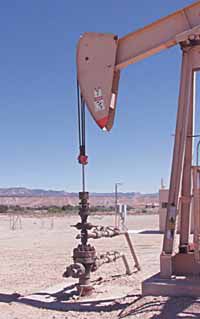| Conditional use permits for gas wells in Carbon County are dependent on many factors. The county’s planning commission decided to revamp the fixed conditions for the wells at a meeting last week and to look at limits on wells based on individual areas particularly in areas where they border residential neighbors such as in the one pictured above. |
The Carbon County planning commission is the body that oversees and recommends to the county commission changes in zoning, conditional use permits (CUP) and looks at development in the area.
On Feb. 4 they hosted their regular meeting and one of the most important topics that evening was the change in the conditions they put on gas wells.
For a number of years, the commission has been using a form that required certain conditions for gas well development and operation. Which conditions apply to which well is often a function of where the well is located in relation to residences, land use in the area and other development.
The form for documenting those conditions is now in the mode of changing to meet the times.
A new draft was presented to the commission last Tuesday, and it had preliminary approval, based on a couple of final changes.
The new form documents the following points a gas company must follow.
•The drilling and operation of the well must comply with all ordinances of Carbon County and the laws of the state of Utah.
•Noxious weeds must be controlled per county ordinances.
•Water runoff and control must be present based on conditions. Ponds must be lined as spelled out by the commission and any ponds must be surrounded by a five foot high fence.
•Reclamation of sites must be done within a time period specified by the commission.
•Any roads damaged by traffic drilling or service to the well must be repaired by the company.
•The aesthetics of the well are important to the surrounding area. Structures and/or pumps should blend in with the natural color and terrain in the area.
•Safe travel speeds for roads should be posted and maintained.
•There are limits to the types of activities that can be performed on the site.
The form also includes add on spaces for specific problems that can be addressed on each individual well site.
While there was no specific language on the form about noise control, the commission agreed that each site should be reviewed for this problem on a site by site basis.
“It’s literally impossible to achieve a zero noise level at the well head, just as it is impossible to have zero noise in any industrial activity on the site where it is happening,” Dave Levanger, the director of planning told the commission. “Noise needs to be examined near the residences it may be affecting.”
Lynna Topolovec brought up the fact that sometimes problems can be brought on by improper placement of industry.
“I wonder if we create our own problems by putting industrial sites in the middle of residential area?” she asked. “I realize they need to exist, but how do we equalize the two so they can co-exist?”
Levanger pointed out that the operative word in conditional use permits and codes is “limits.”
Richard Tatton, commission chair brought up the fact that the blanks on the bottom of the CUP form are what help the commission set individual limits for the development of well sites.
The commission also looked at changing the addressing system in the Scofield and Pleasant Valley area.
In the past the town of Scofield has had a reasonable numbering system, but most of the rest of the area has been literally without addresses or the systems have been mixed. This has caused many problems particularly in connection with emergency response services.
“There are a number of alternatives to doing this,” stated Levanger. “I think we should probably stay with the one that everyone in this state calls the Brigham Young system.”
Most cities in Utah are set up on a grid pattern system that was developed by Young for Salt Lake City when it was settled. That system is presently used in the Carbon County area but has never been put in place for Pleasant Valley. He demonstrated the way addresses are set up when new structures are built.
After the general explanation, he demonstrated how the addressing system would be set up around the reservoir area. Scofield would keep it’s addressing system as it is.
The east-west grid system will be established from a section corner near the cemetery in the town and the north-south coordinates would come from either north or south of the town of Scofield itself.
The commission also decided to allow a lot in Golding Subdivision in Miller Creek that is owned by David and Dee Mann to be split in two. This action came after it was delayed in the January meeting for study after some residents complained about the possible move.
But after looking at the water pressure tests that have been done and listening to the original developer of the subdivision, the commission decided that the split would not be unusual.
The commission also approved a concept design for more lots in the Ballpark Subdivision in Carbonville as well as zone change from R-1-20,000 to C-1 on property owned by Brian Wing at 420 North Fairgrounds Road.
Wing intends on developing the property into medical offices which will be sold to the physicians that place their businesses there.
The commission also voted to reorganize the planning commission with terms moving to five year appointments versus the present three year terms. Members felt that for most people who serve it takes two to three years to get up to speed on what is going on in terms of the business they deal with and the extra two years would take advantage of that experience.

